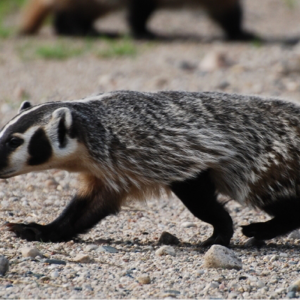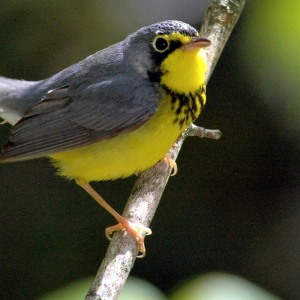Vancouver Island Marmot
Vital Signs
Common name: Vancouver Island Marmot
Latin name: Marmota vancouverensis
Status under SARA: Listed as Endangered as of 2008 assessment
Range: An endemic to the island of Vancouver. Originally found in the Nanaimo Lakes region until it was introduced to other nearby areas.
Life span: It has the average age of 10 yr in the wild and 14 yr in captivity.
Size: It is the largest of the ground squirrels; weighing an average 5 kg and has a nose to tail length of 67-72cm.
Population estimate: In 2007, it was estimated that only 30 remained in the wild. The Marmot Recovery Foundation has since counted 250-300 marmots in 2015.
The Facts
The Vancouver Island Marmot is known as Canada’s panda since it is one of Canada’s wildlife conservation mascots, much like the Giant Panda is in China. These marmots are endemic to Vancouver Island, meaning they’re found nowhere else on Earth, and represent one of the five species of animal that’s endemic to Canada. The species’ range of occurrence has increased over the years due to introduction into new suitable areas on Vancouver Island, but these marmots initially only roamed the sub-alpine meadows of the Nanaimo lakes region.
M.vancouverensis is the largest of the marmot family. They can be described as the size of a large house cat. On average, these marmots weigh 5 kg, with males being larger than females. Females can weigh as low as 3 kg emerging from hibernation and males can weigh as much as 7 kg after foraging throughout the summer months.
Vancouver Island Marmots look like other marmot species overall, but can be differentiated due to their darker chocolate brown coat and irregular white patches around the snout and chest. Other marmot species tend to have more uniform colouration with darker fur on the back and upper body, and lighter underparts.
M.vancouverensis is defined as a colluvial dweller, meaning it chooses its dens in rocky slopes with loose soils and lots of sedimentation from rainwater. These marmots are also social rodents and live in related groups. Family groups can include up to 7 marmots and as the size of the group increases, one will leave to build its own individual den and eventually build its own family group.
Females begin breeding at 3-4 years old and mate once the springtime arrives in late April or May. The gestation period is roughly one month and the female typically gives birth to 3 to 4 young. The pups are born with completely black fur and emerge from the den for the first time in July. Their diet consists of grasses and sedges, and occasionally includes fruit.
The Story
The Vancouver Island Marmot The ICUN Red List lists the Vancouver Island Marmot as Critically Endangered, based on its 2004 assessment. Even with introductions into suitable habitats, only 30-35 individuals are present in the wild. The captive population is scattered in various Canadian zoos, but even if those individuals are used for recovery in the wild, the genetic variation within the species is still decreasing. That can lead to a situation similar to the African Cheetah, which after centuries of “genetic depression” from interbreeding between fewer and fewer individuals, could effectively be wiped out by disease or significant environmental variation.
The major factor preventing these rodents from making a comeback in the wild is predation. Wolves, cougars, and golden eagles, are the three big predators that contribute to exert pressure on the Vancouver Island Marmot population. While predation is natural, it is a threat due to the low population of marmots that has resulted from habitat loss and degradation. The natural sub-alpine meadows that these marmots rely upon have largely been affected by human activities, and the loss of those habitats has affected the marmots much more than other wildlife. Although forest clear-cutting forest actually creates suitable habitat for the Vancouver Island Marmot, it is short-lived. Once the forest regeneration process begins, the marmots are forced out to look for suitable treeless meadow habitats again.
What’s Being Done
M.vancouverensis will disappear if nothing is done and they are at high risk of extinction. They are listed as Endangered under Schedule 1 of Canada’s Species at Risk Act (SARA) and therefore receive full protection from harm on federal lands. However the major problem at hand is that their suitable habitat is extremely limited and they are range-restricted.
Recovery projects for this species include captive-breeding and release, in which marmots are captured, allowed to reproduce in captivity, and later reintroduced in the wild. The question of genetic variation and inbreeding poses the problem of greater risks of genetic depression, disease and adaptability to changing environmental conditions.
Other recovery-related projects for this species include research on marmot demographics, causes of mortality and behavioural responses to predation. The Vancouver Island Marmot is protected under several organizations such as Wildlife Act in B.C, Endangered Species Act in the US, and the Ecological Reserve Act in B.C.
What Can You Do?
In this case, the biggest help you can do is conservation awareness. The more everyone can learn about wildlife, biodiversity and endangered species, the more people will see how much of a difference we can make if we work together to make nature a better home for humans and wildlife. To learn about the Vancouver Island Marmot and the ways you can help, also check out the Marmot Recovery Foundation.
Resources
Marmot Ecology: Hibernation Ecology of Wild and Captive Vancouver Island Marmots
The IUCN Red List of Threatened Species
Vancouver Island Wilderness and Historical Conservation
Biological Conservation: Reintroducing Endangered Vancouver Island Marmots
COSEWIC Assessment and Update Status Report


